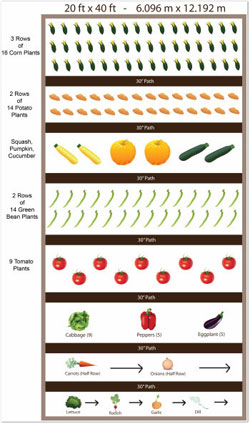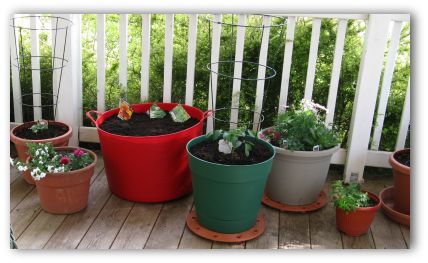Grow a Vegetable Garden

Learn how to grow a vegetable garden, and how to plan a vegetable garden!
We offer free plans for planting and growing vegetables in home vegetable gardens.
Home gardens can be in-ground, raised bed, or container gardens depending on your situation.
Why Plan a Vegetable Garden?
Are you planning to grow a garden this season?
There are more and more good reasons to do just that.
How about learning a new skill, having some fun in the fresh air, saving money while eating really well?
These are just a few good reasons to grow a vegetable garden. Even a small and simple garden can be great place to begin.
Growing Vegetables
Do you want to know a great way to teach your children about healthy eating? Teach them how to grow a garden.
Why a garden? Well, because there is no better way to teach your children how to eat healthy foods than by planting a vegetable garden.
Growing vegetables in home vegetable gardens can be a great project for the entire family to enjoy. Not to mention the fact that really fresh home-grown vegetables just taste better!
How to Grow Vegetables
Download our vegetable garden planting guide.
When planting a vegetable garden, try our vegetable garden planting guide to help determine your garden planting times.
Growing vegetables is really simple, and requires only three things-
But if you want your vegetables to be big and healthy, you will have to dig a bit deeper than that!
How to Grow a Vegetable Garden in Your Backyard
The best place to grow a vegetable garden is in an area of your backyard that consistently gets the most sunshine.
Once you select a patch of earth for growing vegetables, you must loosen up the soil so that the roots of the vegetable can grow.
Click Here for 20X40 Sample Vegetable Garden Plan
Since the soil found in most backyards is often compacted and harder during the summer, the best time for planting a vegetable garden is in the early spring when there is still enough moisture to make digging less of a chore.
Amend and enrich your garden soil by adding and mixing compost, and well-aged manure into the dirt.
Add a layer of mulch to the top of your garden soil to help prevent weeds from sprouting, and to help retain moisture for your plants.
Try Growing Vegetables in a Container Garden on Your Porch, Balcony, or Patio

If you don't have a sunny backyard, or any backyard at all, don't despair! You can easily grow a vegetable garden in containers on your balcony, porch, deck, or patio.
Container gardens are easy to organize, and don't require that least-favorite of all gardening tasks: digging in the ground.

How About Growing Potatoes in Containers?
For a really fun project, try growing a container of potatoes in your garden.
You can use a tub. Or if you want a lot of potatoes, use a garbage can.
Be sure your container has plenty of drainage holes.
Put about 3-4 inches of soil in the bottom of the container.
Lay your seed potatoes on top of the soil.
Cover with about 3-4 inches of soil. Water well.
Wait for the potatoes to sprout. (No peeking.) When the sprouts are about 5-8 inches tall, add 4-5 inches of soil.
Water as needed.
Keep following your potato plants with additional soil half-way up the stems, all the way to the top of the container.
When the plants turn brown and dry, stop watering and wait about 2 weeks to harvest your container of potatoes.
3 Vegetable Gardening Tips
- 1. It is important to follow the planting instructions on your seed packets carefully for seed depth, spacing and thinning.
- 2. Best plants for a summer crop include: tomatoes, eggplant, cucumbers, peppers, squash and bush beans, corn
- 3. Best plants for spring and fall crops include: broccoli, spinach, peas, potatoes and lettuce.

Harvest Time!
Though all plants are different, typically it takes about two to four months for a plant to yield fresh vegetables.
Some crops such as lettuce, corn, radish, and green onions can be planted every three weeks to extend the growing/harvest season.
When your plants are ready to harvest, allow your children to help collect them. They will get a tremendous feeling of satisfaction when they realize they now know how to grow a vegetable garden.
Planting a Vegetable Garden with your Children
Let your children help you plan, plant, water, and care for your vegetable garden. This can do wonders for their willingness to eat their vegetables! There is something very special about planting seeds in the ground, watching and waiting for them to sprout, caring for the small plants, spotting the first little vegetables growing on the plant, and of course tasting the first vegetable from your garden.

